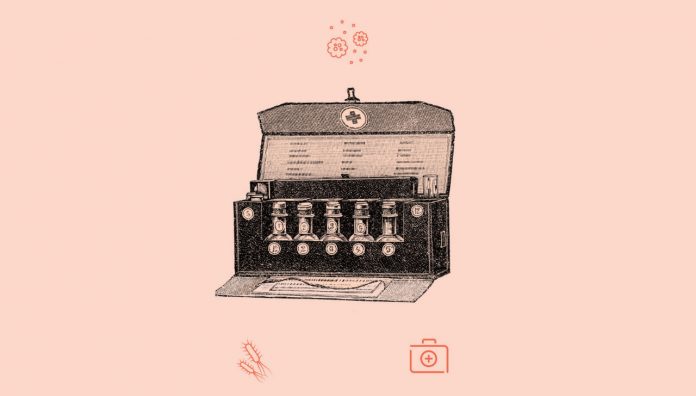One of the first anti-bacterial agents to be used in fields of battle, sulphanilamide was also a factor in the deaths of more than 100 people in peace time when prescribed as an elixir.
Sulphanilamide was first synthesised in 1909 by an Austrian chemist researching dyes. Its curative powers remained unknown until 1932, when its effect against streptococcal infection was confirmed. As Prontosil, the compound was soon in widespread use by the mid 1930s, almost a decade before penicillin was in mass production. As the first systemically active antibacterial agent, sulphanilamide paved the way for the development of antibiotic agents.
How it works
Sulphanilamide (the first of many ‘sulpha’ family drugs) works to completely inhibit enzymatic reactions involving para-aminobenzoic acid in bacteria, which stops bacteria being able to produce folic acid. This means bacteria have no coenzyme to assist in the synthesis of purines and pyrimidines, removing the bacterium’s ability to generate energy, resulting in cell death. Sulphanilamide became widely used in powder and pill form to treat streptococcal infections after 1933. But in 1937 a decision by a Tennessee-based drug company would make it remembered for the wrong reasons – and also change how drugs are developed and tested.
In June 1937, Harold Watkins, chief chemist and pharmacist for the S.E. Massengill Company, followed a request from salesmen and approved an elixir of sulphanilamide using diethylene glycol. It was promptly sent out in 663 shipments across the USA. At this time no drug testing was mandated under the USA’s ‘buyer beware’ culture of the early 20th Century, with the lack of testing contributing to Mr Watkins’ failure to realise diethylene glycol (used widely as an anti-freeze) is highly toxic.
Despite the best efforts of the newly established Food and Drug Administration to recover all of the drug, 105 people are believed to have died from ingesting Elixir Sulfanilamide. The incident spurred legislators to enact the 1938 Federal Food, Drug and Cosmetic Act, which placed more stringent testing requirements before drugs are made available for consumption.
In action
Sulphanilamide would go on to be used widely in the Second World War on both sides of the conflict. It was included in first aid kits supplied to Allied armies. In Germany, experimentation was carried out by Nazi doctors on concentration camp inmates, where patients were inflicted with injuries to test sulphanilamide’s effectiveness.
In Australia, sulphanilamide and others in the ‘sulpha’ family were used by troops during the Second World War. In Papua New Guinea, it was used by Australian troops to treat bacillary dysentery during the Battle of Kokoda.
Modern use
Today sulphanilamide is used to treat vaginal yeast infections, as it has been shown to inhibit the growth of the fungus responsible for the infection.
References
- Costa, Albert B. Gelmo, Paul Josef Jakob. Complete Dictionary of Scientific Biography. 2008. At https://www.encyclopedia.com/science/dictionaries-thesauruses-pictures-and-press-releases/gelmo-paul-josef-jakob
- Sulphanilamide. National Cancer Institute. January 28 2019. At https://ncit.nci.nih.gov/ncitbrowser/ConceptReport.jsp?dictionary=NCI_Thesaurus&ns=NCI_Thesaurus&code=C47738
- Encyclopedia Britannica. Sulfa drug. At https://www.britannica.com/science/sulfa-drug
- Ballentine, Carol. FDA Consumer Magazine. Taste of Raspberries, Taste of Death: The 1937 Elixir Sulphanilamide Incident. June 1981. At: https://www.fda.gov/downloads/AboutFDA/WhatWeDo/History/ProductRegulation/UCM593517.pdf
- Davenport D. The war against bacteria: how were sulphonamide drugs used by Britain during World War II? Medical Humanities 2012;38:55-58. At: https://www.ncbi.nlm.nih.gov/pubmed/21969613
- Tyson, Peter. PBS. The Experiments. At https://www.pbs.org/wgbh/nova/holocaust/experiside.html#sulf
- Australian Academy of Technological Sciences and Engineering. Technology in Australia 1788-1988. Melbourne. November 21 2001. At http://www.austehc.unimelb.edu.au/tia/titlepage.html
- WebMD. Sulfanilamide Cream. At https://www.webmd.com/drugs/2/drug-78027/sulfanilamide-vaginal/details




 ‘We’re increasingly seeing incidents where alert fatigue has been identified as a contributing factor. It’s not that there wasn’t an alert in place, but that it was lost among the other alerts the clinician saw,’ Prof Baysari says.
‘We’re increasingly seeing incidents where alert fatigue has been identified as a contributing factor. It’s not that there wasn’t an alert in place, but that it was lost among the other alerts the clinician saw,’ Prof Baysari says.


 Beyond the arrhythmia, AF often signals broader pathological processes that impair cardiac function and reduce quality of life and life expectancy.5 Many of these conditions are closely linked to social determinants of health, disproportionately affecting populations with socioeconomic disadvantage. Effective AF management requires addressing both the arrhythmia and its underlying contributors.4
Beyond the arrhythmia, AF often signals broader pathological processes that impair cardiac function and reduce quality of life and life expectancy.5 Many of these conditions are closely linked to social determinants of health, disproportionately affecting populations with socioeconomic disadvantage. Effective AF management requires addressing both the arrhythmia and its underlying contributors.4  C – Comorbidity and risk factor management
C – Comorbidity and risk factor management Warfarin
Warfarin







